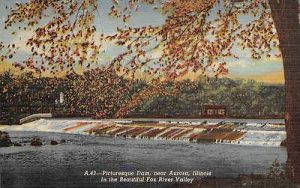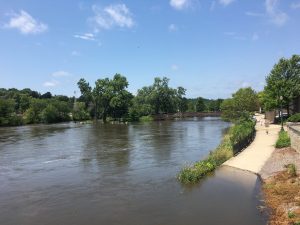by Eric Pepa
When I became a member of Friends of the Fox River several years ago, one of the first things I learned was that we were not Friends of the dams of the Fox River.
As a layperson (an architect by profession), my interest in the Fox River has been mostly recreational. I have grown up around the Fox River, fished it, kayaked and canoed, rode along its bike trails, and enjoyed its natural beauty. The dams just seemed to be a natural part of that beauty, creating the full sensations of being around water- the churn and spray, the rush, the sound and colors. I had no idea that the dams were in any way harmful to the ecology of the river.
Economic and Emotional Engines
The dams have a history that also carries emotional attachment- the Kimball Street Dam in Elgin for example has been in place since the 1880s. And previous versions of the dam in that location date back to 1837. Postcards from our past depict dams from Algonquin to Yorkville.
In Elgin, the dam was built for industrial purposes. A grist mill for processing flour was built on the east side of the river and a sawmill was built on the west side taking advantage of the power generated by the dam.
The historic towns up and down the Fox River valley similarly built dams and mills in the early to mid-1800’s, to grow their population and industrial strength. For over a century the Fox River was used not just for power, but as a dump, and as such became quite polluted.
The dams were integral to that growth, and just about every town had one. In fact, along the Illinois stretch of the Fox River from the border to where it empties into the Illinois River, there are 13 dams remaining from the McHenry Lock and Dam, down to the Dayton Dam in Ottawa. They range from as close as 2 miles apart to over 30 miles apart.
Half the Fox River is a Lake!
Now, the dams are only a vestige of that bygone era. Most of them serve no purpose in terms of hydraulic power or flood control. They do create impoundment areas upstream, which provide deeper water for boating and water activities; however, those impoundments come at a cost. In fact, ecologically, these pools upstream from the dams are not very good for the biology of the river- they have less diverse fish populations, and poorer water quality due to lower levels of dissolved oxygen as compared to free flowing portions of the river.
Gary Swick, president of Friends of the Fox River says the dams “contribute to the growth of ‘nuisance algae’” that those of us who use the Fox River for drinking water have, even after treatment, smelled and tasted on occasion. Surprisingly, these impoundment areas can affect water quality 2 or 3 miles upstream. According to Swick, fully half the river is an impoundment.
Weighing the Costs
In addition to reducing water quality, the dams also prevent the free flow of fish and other aquatic species up and down the river. This has a negative impact on fish as they cannot access tributaries to spawn, and are trapped in segments of the river. Dams limit most aquatic species’ ability to migrate up or down the river. According to the Fox River Study Group, water quality problems because of the dams have contributed to the disappearance of many fish and mussel species over the years.
For the experts who have studied the issue of water quality and ecological health of river species, the answer is clear: remove the dams. For those of us who have grown up in the Fox Valley and have only experienced the river recreationally, that answer is not as easy.
As someone who is just learning about the ecology of the Fox River, I’ve come to understand and appreciate that the benefits of some dam removals significantly outweigh the costs in terms of actual economic cost, as well as the historic and emotional ties we have to the dams.
Don’t Dam Me In!
It is not economically or politically feasible in the near term to remove all, or even most of the dams, but studies and proposals have been brewing for years. In fact, the Kane County Forest Preserve District is making progress with the Illinois DNR to fund removal of the Carpentersville Dam and the Fabyan Forest Preserve Causeway in Geneva. Other dam removals or modifications are also under consideration, such as the St. Charles dam.
According to Executive Director Gary Mechanic: “Friends of the Fox River’s mission is about protecting the river and improving its water quality. Our mission also includes restoring the river to full health. So we believe it is important to educate people about the many negative effects the dams have on the quality of water and aquatic species in the Fox River, and promote a free flowing river unrestricted by outmoded dams.”
If you’d like to learn more about the dam question, there are many good resources on the FOTFR website at https://friendsofthefoxriver.org/resources/water-quality/
For more information on the effect dams have on water quality, visit the Fox River Study Group: http://www.foxriverstudygroup.org/





This is ridiculous! Everyone is out of work and you want to sit around and tamper with a dam. This is going to cost our state and our citizens tens of millions of dollars, when people can’t even find jobs that even support their families or get Congress to pass a stimulus bill that will help to keep our economy rolling (because no one has any work). Yet your organization wants millions upon millions from a state which continues to cry broke. I don’t think so. Leave it alone!
Marie,
Thank you for your comments and concerns. They are important.
Times are difficult, but progress solving the problems of today and tomorrow is exactly what successful stimulus programs in the past have done. Part of that stimulus work is providing the information necessary to inform us where best to direct our resources.in order to benefit ourselves and future generations.
Removal of the Kimball Street dam will provide nearly a million dollars in jobs. More to the point, as discussed at the Elgin City Council meeting, its removal has a significant chance saving us from much larger expenses in the future.
The problem at hand today is that our river intake has experienced problems with sediment and freezing for nearly 20 years, problems that threaten Elgin’s water supply. If the Nelson plant river intake had been sited on the east bank when built nearly forty years ago the river current would have kept it clean. It was built on the west bank.
We can’t second guess all the factors that went into that siting decision so long ago but it is clear we have a problem that needs to be addressed whether the dam comes out or not. The dam removal cost is only a small fraction of the $15 million projected for the two projects.
The effort to protect and restore our Fox has extended since well before the 1917 Illinois Sanitary District Act over 100 years ago when the river ran with filth. Removal of the Kimball Street dam is another important step along that journey, and by any historic measure, an inexpensive one that deserves all of our support. In that context I hope it will earn yours.
Thank you again for bringing your thoughts to our attention.
Sincerely,
Art Malm, FOFR Director